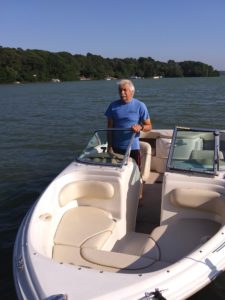President’s Letter July 2022
 Summer is here and we are already swimming, fishing, and boating on our beloved ponds. Let’s not forget to take a hike or two on the Comassakumkanut and Alper Preserves, land within our recharge area that your donations helped Plymouth to purchase and conserve. In the latter, many plants have been tagged for identification (your children and grandchildren can show you how to do this on your phone) and both preserves have a wealth of flowers, birds, and mushrooms.
Summer is here and we are already swimming, fishing, and boating on our beloved ponds. Let’s not forget to take a hike or two on the Comassakumkanut and Alper Preserves, land within our recharge area that your donations helped Plymouth to purchase and conserve. In the latter, many plants have been tagged for identification (your children and grandchildren can show you how to do this on your phone) and both preserves have a wealth of flowers, birds, and mushrooms.
Will there be a cyanobacteria bloom this summer? We are all ready for this summer spoiler to be gone forever. We’re doing many of the right things to make sure that this happens. You have generously donated to the Water Quality Plan study that will identify the source (s) of the phosphorus pollution responsible for these cyanobacteria blooms and suggest what can be done to stop them from occurring. Recently, we were told that the first draft of the Plan will be available sometime in early July.
We are poised for action. A Board of Directors committee of myself, Geri Williams, Jack Kedian, Jerry Levine, Brian Harrington, Paul Denoncourt and Tom O’Brien will review the Plan draft, ask questions of the consultant, and engage outside experts if needed. Information has been gathered in the interim to guide us in this process. If alum treatment is suggested for phosphorus control, Kim Tower has already participated in that process at White Island Pond. Although expensive, its effects have been known to last a decade or more and alum can be applied carefully to minimize effects on pond flora and fauna.
Moreover, having a consultant-generated study and a partnership with Plymouth will put any HPWA grant application at or near the top of the list.
Once the report is in its final form, we will share it with you. The consultant will do a formal presentation and we will hold as many sessions as needed to get the word out and make sure that all your questions have been answered.
Meanwhile, what can we all do to reduce the likelihood of cyanobacteria blooms?
- Maintain septic systems and storm drains
- Reduce application of fertilizer
- Pick up pet waste
- Plant and/or maintain native vegetation around the water’s edge
- Avoid clear cutting on steep slopes near the water
Hot off the presses, we have had some appearances of cyanobacteria the last week of June. Although they have been identified as cyano, they have not been persistent, nor widespread, resembling their behavior in the years before the first 2020 bloom where they seemed unable to gain traction. The sample we sent out for testing from the Eagle Hill Cove on June 28 contained substantial cyano cells but had negligible toxin. The total phosphorus (the pollutant of choice for cyano) reading of a sample taken of Great Herring Pond on June 21 had only 0.014 mg/L, lower than a Little Herring Pond Spring (aquifer) reading of 0.016 mg/L. There may not be enough phosphorus to sustain a bloom. Moreover, In the bloom years of 2020 and 2021, once the bloom started, it spread quickly. We are not seeing this behavior so far this year. Out of caution, if you see a light green scum on the water in front of your home, keep dogs, children and sensitive people out of the water until the bloom dissipates. We will do our best to keep you informed of pond conditions via email and HPWA Facebook page.
Our HPWA Membership Drive is in full swing. Your donation or membership to HPWA enables us to maintain and improve our watershed. Please consider helping to protect our beautiful pond/pine barrens environment for our children, grandchildren, and all future generations.
Please mark your calendar to join us at the HPWA PICNIC on Saturday August 6 at 3 PM at the Weston’s Bog at 173 Herring Pond Road.
Don Williams
President, HPWA

Comments
President’s Letter July 2022 — No Comments
HTML tags allowed in your comment: <a href="" title=""> <abbr title=""> <acronym title=""> <b> <blockquote cite=""> <cite> <code> <del datetime=""> <em> <i> <q cite=""> <s> <strike> <strong>